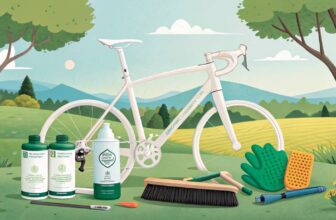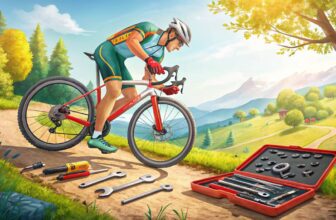Understanding Wheel Truing
Wheel Truing Basics
Wheel truing is all about getting those bike wheels as round and straight as possible. Picture it as giving your bike a visit to the spa. It involves a simple tool called a spoke wrench that tweaks the spokes until they hug the rim perfectly around the hub. Trust me, your wheel will thank you for it, and—bonus—it’ll even ride smoother (Park Tool).
The main things you wanna make sure are right:
- Lateral Truing: Stops the wheel from doing the shimmy-shammy side to side.
- Radial Truing: Keeps the wheel from pretending it’s a pogo stick.
- Dish/Centration: Gets the wheel smack dab in the middle of the bike frame.
- Spoke Tension Optimization: Levels out the spokes’ tightness so they hold together through thick and thin.
Importance of Wheel Truing
Why bother with wheel truing at all? Well, think about cruising around on a wobbly wheel—yikes! Keeping your wheels in line isn’t just for looks—it’s a big deal for safety, how well your bike performs, and saving you some bucks down the road.
Why You Should Care About Wheel Truing:
- Safety: You wouldn’t drive a car with a wiggly tire; a wonky wheel on your bike is just as dodgy. Regular sprucing keeps you and your ride safe from unexpected tumbles.
- Performance: When your wheels roll like they’re on rails, pedaling feels less like a chore and more like a glide. Handy for everyone from speed demons to daily pedalers (competitive cyclists, commuters, you get it).
- Component Life Span: Uneven tension is just a fancy way of saying trouble ahead—think snapped spokes or busted rims. Keeping everything nice and even extends your wheel’s shelf life, and who doesn’t love getting the most bang for their buck (bike budgeters)?
Do you have a truing stand? Awesome! It’s like having an extra pair of hands while you’re tweaking. But if not, the old “use-the-bike” trick still does wonders if you find a way to let that wheel spin (Park Tool). Understanding these basics makes for happy wheels and even happier riders. Check out our bike repair guides and bike maintenance schedule for more no-nonsense tips on keeping your ride rolling right!
Tools Needed for Wheel Truing
Proper wheel truing calls for just the right gadgets to make sure your wheel isn’t wobbling like a wonky carnival ride. If you’re looking to keep that bike of yours in tip-top shape, you’ll want to get cozy with these essential types of equipment: a spoke wrench, a truing stand, and a spoke tension meter.
Spoke Wrench
Meet the VIP of wheel truing: the trusty spoke wrench. This little gizmo is all about getting the tension right on your spokes. Picture it as the superhero turning the spoke nipple into submission to keep your wheels running like a dream. Getting those spokes just right is the secret sauce for keeping your wheels true. Check out Park Tool for more.
| Spoke Wrench | What’s It Do? |
|---|---|
| Spoke Wrench | Tweaks spoke nipple tension |
For tips on not falling out with your spoke wrench, swing by our bike spoke maintenance page.
Truing Stand
Next up in your truing toolbox is the truing stand—the unsung hero that holds your wheel steady while you’re working your magic. Whether you’re cutting your teeth on basic stands or splashing the cash on high-end models with all the bells and whistles, you’ll find the right stand’s gonna help you spot little hiccups in the wheel. Dive into more details over on Bike Radar.
| Truing Stand | What’s It Do? |
|---|---|
| Truing Stand | Keeps your wheel steady and highlights issues |
Want the inside scoop on the truing stand know-how? We’ve got the lowdown over on our true bike wheel article.
Spoke Tension Meter
Enter the precision player: the spoke tension meter, or tensiometer if you’re feeling fancy. It takes measuring tension to the next level, ensuring your ride’s smooth and steady down the road. Believe me, you’ll want this to keep those wheels true when you hit the pavement. Check out the Park Tool TM-1—it comes highly recommended (Park Tool).
| Spoke Tension Meter | What’s It Do? |
|---|---|
| Spoke Tension Meter | Pinpoints spoke tension with precision |
For tricks to keep your spokes singing in harmony, hop over to our wheel building guide.
Getting to grips with these tools means smoother rides and less fuss. Amp up your bike-fixing prowess by browsing our must-read bike repair guides for all things DIY cyclists.
The Process of Wheel Truing
Getting your head around wheel truing is a must-do for any cyclist who wants their bike to keep running smoothly. Whether you’re tackling rough trails or cruising city streets, having a well-balanced wheel is your bike’s best bud. We’re diving into the three big steps here: lateral truing, radial truing, and wheel dishing. Each plays a part in keeping your bike running without a hitch.
Lateral Truing
Lateral truing is kind of like giving your wheel a tune-up to stop the side-to-side bobbing. You tweak the spokes—tighten one side, loosen the other. Think of it as finding your wheel’s sweet spot so it stays true and keeps you riding steady.
| Got an Issue? | What to Do |
|---|---|
| Rim nudges right | Tighten the left, loosen the right |
| Rim nudges left | Tighten the right, loosen the left |
Need more? Visit our page on true bike wheel expertise.
Radial Truing
Radial truing is where you sort out the wheel’s up-and-down dance. By adjusting pairs of spokes, you can move the rim up or down to get everything aligned and make that wheel spin smoothly.
| Got an Issue? | What to Do |
|---|---|
| Rim’s too high | Tighten those nearby spokes |
| Rim’s sagging low | Loosen those nearby spokes |
Building on lateral truing, radial adjustments are your secret to a perfect wheel. Discover more handy repair tips here.
Wheel Dishing
Wheel dishing is all about centering the rim over the hub—picture it as lining up your shot in the pool. Use gadgets like wheel alignment gauges to get it just right. It’s crucial to keep your bike performing like a champ.
To check your wheel dishing, slap down a gauge, fiddle with the spokes, and watch everything fall into place. More wheel tricks can be found in our bike spoke maintenance guide.
Whether you’re a newbie or a seasoned rider, keeping your wheels true is key for smooth sailing. Want even more bike know-how? Dig into our articles on bike maintenance schedules and fix bike flat tire. You’ll find everything you need to keep pedaling confidently.
Using a Truing Stand
For the bike enthusiast who likes their wheels to run smooth and sleek, a truing stand is the holy grail of wheel maintenance. Let’s see how you can make the most out of it.
Benefits of a Truing Stand
A truing stand has perks you’ll appreciate:
- Rock Solid Stability: Holds your wheel steady, making it easier to spot those pesky wobbles and flicks while you work your magic on them. No more guessing games!
- User-Friendly: Designed to keep your workspace neat and your readings spot-on. It’s your toolshed’s best friend (Park Tool).
- Pinpoint Accuracy: Comes equipped with indicators that help you spot even the tiniest misalignments. It’s like having a magnifying glass for your bike wheel.
Craving more on bike TLC? Check out our nugget of wisdom-filled articles on bike repair guides and the best bike work stands.
Adjusting Spoke Tension
Got a wobbly wheel? Here’s how to tame those spokes:
- Spoke Wrench 101: Your trusty tool to twist and tweak the spoke nipple.
- Clockwise or Counterclockwise?:
- Turn right (tighten) for more tension.
- Turn left (loosen) for less tension.
- Fine-Tuning: Use your wrench to give those spokes some lovin’ and get that wheel ride-ready (Park Tool).
| Twist Move | What Happens? | What It Does |
|---|---|---|
| Righty-Tighty | Spoke firms up | Tension rises |
| Lefty-Loosey | Spoke slackens | Tension drops |
Need the lowdown on the nuts and bolts of bike tools? Peek at our bike tool kit essentials.
Indicators for Truing
These little helpers are your wheel’s best buddies:
- Built-in Friendly Pointers: These do the detective work, sniffing out misalignments as your wheel spins away merrily.
- DIY Quick Fix: No truing stand? No worries! Grab some zip ties, hitch ’em to the frame, and let them be your homemade guides (Park Tool).
Noticing the wiggles before they become wobbles can save you lots of hassle. For more handy-dandy bike tricks, see our bike maintenance schedule and true bike wheel pages.
Grasp the how-tos of a truing stand, get those spokes in line, and let those indicators guide your way—your bike wheels will be as true as can be.
Wheel Truing Techniques
So you’re itching to fix that wobbly bike wheel? Let’s get into the nitty-gritty of how to straighten it up. Here’s a lowdown on how to measure and mend those pesky side-to-side (lateral) and up-and-down (radial) wobbles, ensuring your wheel spins as smooth as a buttered pancake.
Measuring Lateral Deviations
Anyone who’s ever faced a wheel that looks like it’s trying out for a hula-hooping contest knows the frustration. Lateral truing corrects those side shuffles when your wheel wobbles just a bit too much. Such tweaking is key for top-notch bike handling when you’re cruising or racing.
Steps to Measure Lateral Deviations:
- Fix your wobbly wheel onto a snazzy truing stand and give it a whirl.
- Keep your eyes peeled on how the rim moves past the truing stand’s markers.
- Pinpoint those parts where the rim does the shimmy—left or right.
- Here’s a trick: tighten the opposite side spokes to pull the rim over, while loosening the ones on the wobbly side.
Measuring Radial Deviations
For a wheel that bounces like a kid on a trampoline, radial truing sorts out the ups and downs. Balancing radial wobbles completes the job lateral truing started and keeps everything properly rounded.
Steps to Measure Radial Deviations:
- With the wheel on the stand, let it spin like a record.
- Watch the rim’s vertical dance with the stand’s indicators.
- Find those peaks and valleys on the rim.
- Tinker with pairs of spokes at the valleys (tighten them) to raise the rim and at the peaks (loosen them) to lower it.
Achieving Roundness in the Wheel
Combining lateral and radial tweaks gets that perfect circle you’re dreaming of. When your wheel’s as round as can be, your ride’s smooth, and your bike’s integrity stays intact.
Steps to Achieve Roundness:
- Start by nailing those lateral wobbles.
- Move on to nudging the wheel into vertical perfection.
- Keep spinning your wheel, adjusting here and there till both lateral and radial nudges show minimal hiccups.
- Your goal: a wheel that’s all about balance, no hiccups.
| Deviation Type | Way to Fix It | What You Need |
|---|---|---|
| Lateral Deviation | Tweak spokes to steady the rim | Truing Stand, Spoke Wrench |
| Radial Deviation | Work those spoke pairs for a smooth roll | Truing Stand, Spoke Wrench |
| Achieving Roundness | Lateral and radial adjustments combined | Truing Stand, Spoke Wrench |
Need more biking wisdom? Jump into our help desk with guides on flattening a bike’s flat tire, tuning up bike brakes, or sorting your bike maintenance timelines. And don’t forget your must-haves in our bike tool kit essentials.




